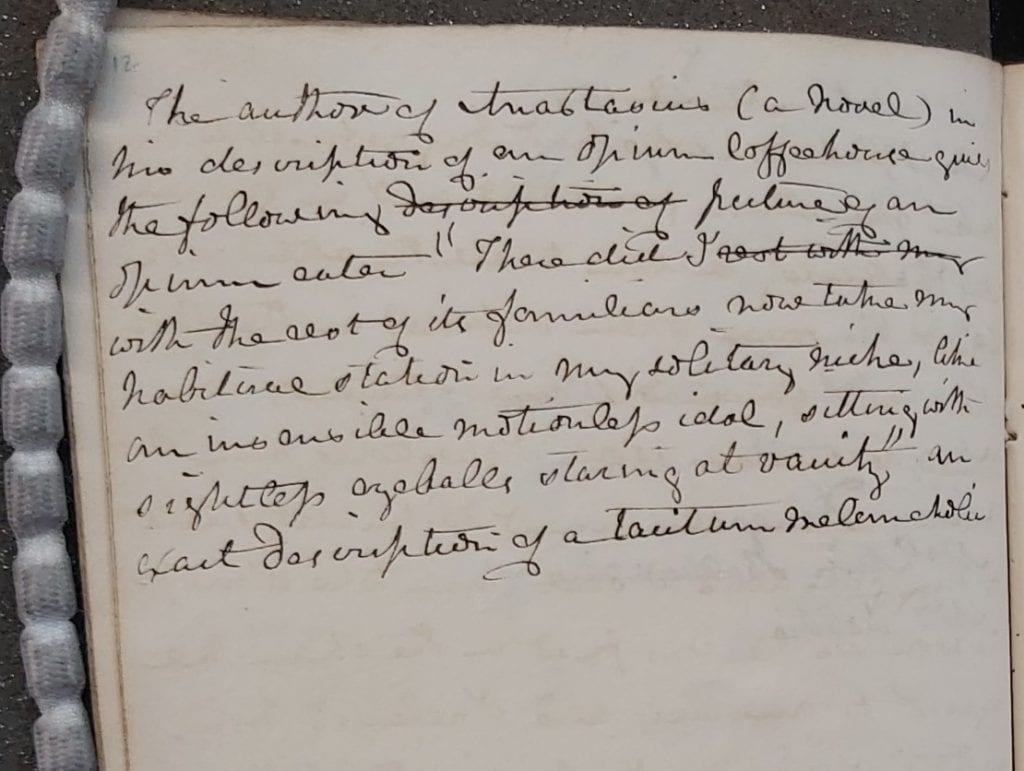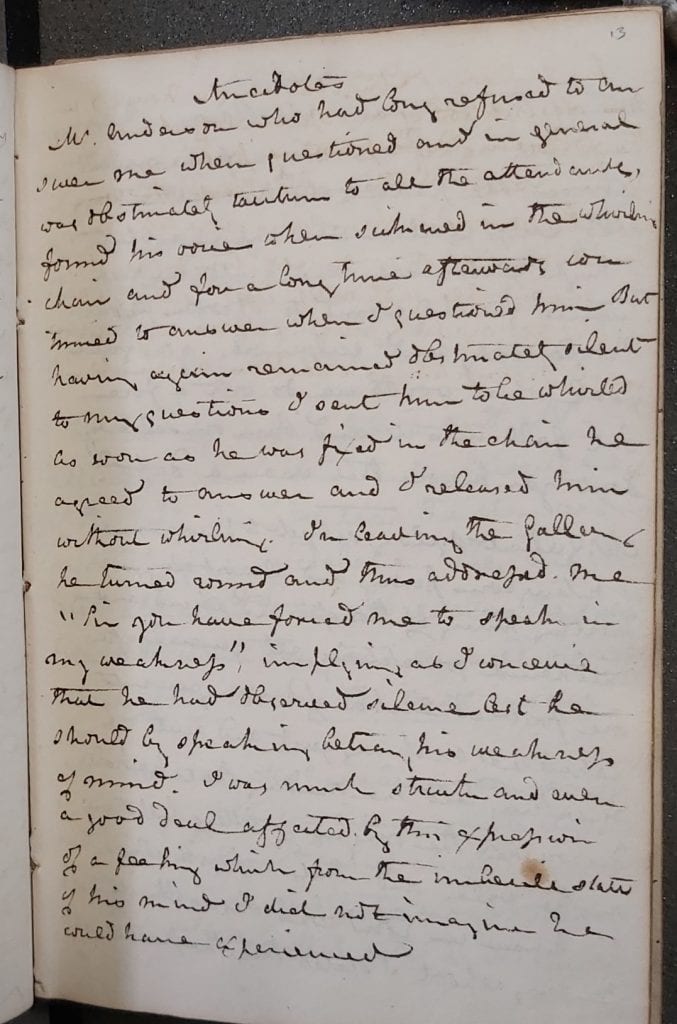Dr John Balmanno’s ‘Anecdotes’ from Glasgow’s Gartnaval Asylum were written between 1821 and 1840 when Balmanno was physician there. They are an unusual record of patient case histories, often providing details of interaction between the patient and the doctor, or between patients, using quotes from the patients, and often recording the doctor’s feelings about the cases. This is in contrast to the clinical notes more commonly found in this period and in the College’s collections. The anecdotes are at the rear of Dr Robert Cleghorn’s case notes of patients from the asylum, dated 1814 (RCPSG 1/20/2/2), which conform to the common style of recording clinical details, medication, and physical symptoms. Cleghorn preceded Balmanno as physician at the asylum, being the first appointed in 1814 until 1821.
This blog post uses terminology from the original archive material, for example in the titles of archive items, and in transcriptions from case notes. This terminology reflects the very different attitudes towards, and labelling of, mental illness in the 19th century, and its use here in no way signals acceptance of these terms.
Background
The catalogue entry for the casebook says – “Case notes of patients from the Glasgow Asylum for Lunatics in the hand of Robert Cleghorn with further notes by Dr John Balmanno. Anecdotes by Balmanno at the back of the volume. Book plate by William James Fleming MD.”

Dr John Balmanno (c1775 – 1840) was President of the Royal College of Physicians and Surgeons of Glasgow twice, in 1802 and in 1814. The portrait in the College’s collections is by Sir Henry Raeburn (disputed) or Sir Daniel MacNee. As with Cleghorn’s portrait, it was originally housed in Gartnaval, loaned to the College, and eventually transferred there.
Balmanno Street (near the University of Strathclyde) was named in commemoration of John and his mother, who had an apothecary shop nearby in the old centre of Glasgow.
Balmanno was admitted to the College in 1801, and became Chair of Materia Medica at Anderson’s University, and physician at Glasgow Royal Infirmary in 1804. He became well known for his part in the medical community’s response to Glasgow’s fever epidemics, for example in 1818. The College’s collections contain three large silver salvers inscribed to Balmanno, memorializing his contribution to the response to the epidemics.
Anecdotes
Anecdote is an unusual term to see in the context of 19th century medical case notes of patients (anecdotes of the work and lives of doctors was more common). The position of the anecdotes at the rear of Cleghorn’s casebook is also unusual. Most physicians and surgeons were keen to have the record of their professional practice clearly identified as theirs. Even if marked as private, notebooks and diaries were clearly stamped as unique objects specific to their owner, as a record of his contribution to medicine. The creation of a personal archive, a legacy of the doctor’s place in the medical community, was a common pursuit of the 19th century physician.
The definition of ‘anecdote’ in the 19th century (from Encyclopedia Britannica) outlines two meanings. First, “something not published, in which sense it has been used to denote either secret histories, […] or portions of ancient writers which have remained long in manuscript and are edited for the first time.” Second, “Anecdotes are relations of detached interesting particulars […].” In more recent times, a common definition of medical anecdotes is “a brief report of an isolated or unique observation”.
The first case – Mr Anderson
The first page of Balmanno’s anecdotes is numbered page 13. The facing page (12) contains a note, which serves as an interesting preamble to the first case, in which the patient is described as “obstinately taciturn”. The transcriptions below include Balmanno’s editing and strikethroughs where possible. Words not yet transcribed are blank in square brackets. Unclear transcriptions are also in square brackets.

“The author of Anastasius (a novel) in his description of an opium coffeehouse gives the following description of picture of an opium eater ‘There did I rest with my with the rest of its familiars now take my habitual station in my solitary niche, like an insensible, motionless idol, sitting with [sightless?] eyeballs staring at vanity” an exact description of a taciturn melancholic.”
The first anecdote relates the case of Mr Anderson, who Dr Balmanno is struggling to communicate with. Balmanno suggests that the threat of the ‘whirling chair’ encourages, or more accurately, forces the patient to speak. But the main focus of the anecdote is the patient’s verbal response to this action, how he expresses it, and Dr Balmanno’s reflections on this.

“Mr Anderson who had long refused to answer me when questioned and in general was obstinately taciturn to all the attendants […] But having again remained obstinately silent to my questions I sent him to be whirled [ ] as soon as he was fixed in the chair he agreed to answer and I released him without whirling. […] he turned around and thus addressed me
‘Sir you have forced me to speak in my weakness,’ implying [that?] [I convinced?] that he had observed silence lest he should by speaking betray his weakness of mind. I was much [ ] and even a good deal affected by this expression of a feeling which from the [infantile?] state of his mind I did not imagine he could have experienced.”
It is clear from the anecdote that Mr Anderson was being treated with the whirling chair as a method of punishment or threat. The whirling chair, which was also known as a swing chair or Cox’s swing, was used in rotation therapy in asylums from the late 18th century to around 1830. For an excellent history of rotation therapy see the article by Dr Sheila Dickson of the University of Glasgow – “Rotation therapy for maniacs, melancholics and idiots: theory, practice and perception in European medical and literary case histories” (History of Psychiatry, 29(1) 2018).
As Dr Dickson explains, rotation therapy ranged in its uses, from soothing the patient to inducing excitement, irritability and sickness. It seems from Balmanno’s anecdote that even the threat of the chair was part of the patient’s treatment. Balmanno refers to Anderson being “fixed” in the chair (i.e. restrained) and then “released” without whirling because he agreed to answer him. Anderson, in Balmanno’s paraphrasing, says “you have forced me to speak in my weakness”. Balmanno interprets this as Anderson expressing his “weakness of mind”. This expression of sensibility from such an “infantile state” of mind leaves Balmanno “a good deal affected”. However, he doesn’t seem to consider that Anderson was expressing a submission to weakness caused by the threat of the whirling chair. He has been “forced to speak” because of this threat.
While this single anecdote highlights the often disturbing treatment of the mentally ill in asylums in the 19th century, it also suggests shifts in attitudes and awareness of patients as individual personalities. Balmano’s anecdotes capture many such exchanges and encounters between doctor and patient, revealing something of both, and presenting a world in which dialogue is becoming increasingly important.
You can find out more about the College’s collections on the Heritage website – https://heritage.rcpsg.ac.uk/collections.


Leave a Reply